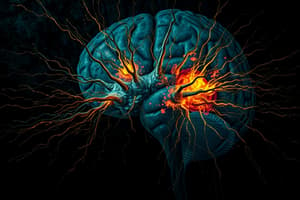Podcast
Questions and Answers
What is the primary focus of seizure semiology?
What is the primary focus of seizure semiology?
- Analyzing the genetic causes of epilepsy
- Studying observable clinical signs and symptoms during a seizure (correct)
- Developing new medications to prevent seizures
- Studying the financial impact of seizures on patients
What is the purpose of studying observable clinical signs and symptoms during a seizure?
What is the purpose of studying observable clinical signs and symptoms during a seizure?
- To provide emotional support to individuals experiencing seizures
- To predict the weather patterns that might trigger seizures
- To locate the part of the brain where seizures start (correct)
- To determine the cost of treating seizures
According to the content, which of the following are especially important for localization during a seizure?
According to the content, which of the following are especially important for localization during a seizure?
- Dietary habits and exercise routines
- Aura and motor signs (correct)
- Family history and genetic predispositions
- Financial records and medical bills
Which type of somatosensory aura is commonly experienced during a seizure?
Which type of somatosensory aura is commonly experienced during a seizure?
What type of aura involves simple sounds or voices/music?
What type of aura involves simple sounds or voices/music?
Which lobe is typically involved in olfactory auras?
Which lobe is typically involved in olfactory auras?
A person experiencing flashes of light or static is most likely having what kind of aura?
A person experiencing flashes of light or static is most likely having what kind of aura?
What brain regions are associated with abdominal auras?
What brain regions are associated with abdominal auras?
Which of the following is associated with psychic auras?
Which of the following is associated with psychic auras?
Palpitations and piloerection are signs of what type of aura?
Palpitations and piloerection are signs of what type of aura?
During a seizure, if a patient's head and eyes deviate, it is typically __________ to the seizure focus.
During a seizure, if a patient's head and eyes deviate, it is typically __________ to the seizure focus.
During a seizure, if a patient has unilateral clonic activity, it is typically __________.
During a seizure, if a patient has unilateral clonic activity, it is typically __________.
Dystonic posturing during a seizure is most commonly observed in which type of epilepsy?
Dystonic posturing during a seizure is most commonly observed in which type of epilepsy?
If a patient exhibits the 'Figure-of-4' sign during a seizure, which arm is extended?
If a patient exhibits the 'Figure-of-4' sign during a seizure, which arm is extended?
Ictal spitting or vomiting during a seizure is most often associated with which hemisphere?
Ictal spitting or vomiting during a seizure is most often associated with which hemisphere?
Which hemisphere is indicated by ictal speech during a seizure?
Which hemisphere is indicated by ictal speech during a seizure?
Which hemisphere is indicated by speech arrest during a seizure?
Which hemisphere is indicated by speech arrest during a seizure?
What is Todd's paralysis?
What is Todd's paralysis?
Postictal aphasia suggests involvement of which hemisphere?
Postictal aphasia suggests involvement of which hemisphere?
Postictal nose wiping is typically __________.
Postictal nose wiping is typically __________.
In seizure semiology, what is a key application of studying aura and motor signs?
In seizure semiology, what is a key application of studying aura and motor signs?
A patient reports experiencing a sensation of tingling and numbness during a seizure. Which brain region is most likely involved?
A patient reports experiencing a sensation of tingling and numbness during a seizure. Which brain region is most likely involved?
Which neural structure is most likely implicated in a patient experiencing olfactory auras before a seizure?
Which neural structure is most likely implicated in a patient experiencing olfactory auras before a seizure?
A patient undergoing a seizure exhibits a 'Figure-of-4' sign on their left side. What does this indicate about the seizure focus?
A patient undergoing a seizure exhibits a 'Figure-of-4' sign on their left side. What does this indicate about the seizure focus?
A patient is observed to have violent, thrashing movements during a seizure. Which area of the brain is most likely involved?
A patient is observed to have violent, thrashing movements during a seizure. Which area of the brain is most likely involved?
During a neurological assessment, a patient suddenly experiences a gustatory aura. Which area of the brain is likely involved?
During a neurological assessment, a patient suddenly experiences a gustatory aura. Which area of the brain is likely involved?
What is the significance of unilateral eye blinking as an ictal sign during a seizure?
What is the significance of unilateral eye blinking as an ictal sign during a seizure?
A patient demonstrates speech arrest during a seizure. Which of the following is most likely?
A patient demonstrates speech arrest during a seizure. Which of the following is most likely?
A patient exhibits postictal coughing and water drinking. Which hemisphere is most likely involved?
A patient exhibits postictal coughing and water drinking. Which hemisphere is most likely involved?
Which brain area is most likely involved when a patient reports experiencing a sense of déjà vu during a seizure?
Which brain area is most likely involved when a patient reports experiencing a sense of déjà vu during a seizure?
A patient experiences autonomic auras during a seizure. Which of the following is least likely to be involved?
A patient experiences autonomic auras during a seizure. Which of the following is least likely to be involved?
What is the significance of the 'rising sensation' in the abdomen as an aura symptom during a seizure?
What is the significance of the 'rising sensation' in the abdomen as an aura symptom during a seizure?
A patient's head and eyes deviate to the left during a seizure. What does this indicate?
A patient's head and eyes deviate to the left during a seizure. What does this indicate?
A patient exhibits ictal speech during a seizure. Which hemisphere is most likely involved?
A patient exhibits ictal speech during a seizure. Which hemisphere is most likely involved?
What is the primary significance of postictal lateralizing signs in seizure semiology?
What is the primary significance of postictal lateralizing signs in seizure semiology?
During a seizure, a patient is observed making repetitive hand and mouth movements. Which area of the brain is most likely involved?
During a seizure, a patient is observed making repetitive hand and mouth movements. Which area of the brain is most likely involved?
A patient experiences localized weakness on the left side of their body following a seizure. Which of the following is most likely?
A patient experiences localized weakness on the left side of their body following a seizure. Which of the following is most likely?
A patient exhibits dystonic posturing during a seizure. Which condition is this most commonly observed in?
A patient exhibits dystonic posturing during a seizure. Which condition is this most commonly observed in?
After a seizure, a patient exhibits aphasia. Which hemisphere is most likely involved?
After a seizure, a patient exhibits aphasia. Which hemisphere is most likely involved?
During an evaluation, a patient has gelastic seizures. What underlying condition should be suspected?
During an evaluation, a patient has gelastic seizures. What underlying condition should be suspected?
Flashcards
Seizure Semiology
Seizure Semiology
The study of observable clinical signs and symptoms during a seizure, which helps locate where seizures start in the brain.
Somatosensory Aura
Somatosensory Aura
Tingling or numbness. It localizes to the contralateral somatosensory cortex (parietal lobe).
Auditory Aura
Auditory Aura
Simple sounds or voices/music. It localizes to the auditory association cortex including Heschl's gyrus.
Olfactory Aura
Olfactory Aura
Signup and view all the flashcards
Visual Aura
Visual Aura
Signup and view all the flashcards
Abdominal Aura
Abdominal Aura
Signup and view all the flashcards
Psychic Aura
Psychic Aura
Signup and view all the flashcards
Autonomic Aura
Autonomic Aura
Signup and view all the flashcards
Head/Eye Deviation (Ictal)
Head/Eye Deviation (Ictal)
Signup and view all the flashcards
Unilateral Clonic Activity (Ictal)
Unilateral Clonic Activity (Ictal)
Signup and view all the flashcards
Dystonic Posturing (Ictal)
Dystonic Posturing (Ictal)
Signup and view all the flashcards
"Figure-of-4" Sign (Ictal)
"Figure-of-4" Sign (Ictal)
Signup and view all the flashcards
Ictal Spitting/Vomiting
Ictal Spitting/Vomiting
Signup and view all the flashcards
Unilateral Eye Blinking (Ictal)
Unilateral Eye Blinking (Ictal)
Signup and view all the flashcards
Ictal Speech
Ictal Speech
Signup and view all the flashcards
Speech Arrest (Ictal)
Speech Arrest (Ictal)
Signup and view all the flashcards
Todd's Paralysis (Post-Ictal)
Todd's Paralysis (Post-Ictal)
Signup and view all the flashcards
Postictal Aphasia
Postictal Aphasia
Signup and view all the flashcards
Postictal Nose Wiping
Postictal Nose Wiping
Signup and view all the flashcards
Postictal Cough/Water Drinking
Postictal Cough/Water Drinking
Signup and view all the flashcards
Hypermotor Seizure
Hypermotor Seizure
Signup and view all the flashcards
Automotor Seizure
Automotor Seizure
Signup and view all the flashcards
Gelastic Seizure
Gelastic Seizure
Signup and view all the flashcards
Study Notes
- Seizure semiology is the study of clinical signs/symptoms during a seizure.
- Seizure semiology aids in locating the brain's epileptogenic zone, where seizures begin.
- Auras and motor signs play a key role in localization.
Common Auras & Localization
- Somatosensory auras manifest as tingling/numbness in the contralateral somatosensory cortex (parietal lobe).
- Auditory auras involve simple sounds (Heschls gyrus) or voices/music (auditory association cortex).
- Olfactory auras involve smell in the mesial temporal (amygdala), orbitofrontal, or insula regions.
- Gustatory auras involve taste, localized to the parietal operculum, insula, or mesial temporal regions.
- Visual auras can be flashes or static and are linked to the occipital cortex (areas 17, 18, 19), while scenes/people are linked to the temporo-occipital region.
- Abdominal auras have a rising sensation linked to the insula or mesial temporal lobe, often seen in temporal lobe epilepsy.
- Psychic auras can manifest as emotions or déjà vu, linked to the amygdala, hippocampus, or temporal cortex.
- Autonomic auras include palpitations, piloerection, or genital sensations, linked to the insula, cingulate, or SMA.
Lateralizing Ictal Signs (During Seizure)
- Head/Eye Deviation shifts contralaterally to the seizure focus.
- Unilateral Clonic Activity occurs contralaterally.
- Dystonic Posturing presents contralaterally, especially in temporal lobe epilepsy (TLE).
- The Figure-of-4 Sign, where the extended arm is contralateral.
- Ictal Spitting/Vomiting originates in the right or non-dominant hemisphere.
- Unilateral Eye Blinking occurs ipsilaterally.
- Ictal Speech disturbances originate in the non-dominant hemisphere.
- Speech Arrest points to the dominant hemisphere.
Post-Ictal Lateralizing Signs (After Seizure)
- Todd's Paralysis causes weakness on one side, contralateral to the seizure focus.
- Postictal Aphasia suggests involvement of the dominant hemisphere.
- Postictal Nose Wiping is ipsilateral, especially in temporal lobe epilepsy (TLE).
- Postictal Cough or Water Drinking occurs in the non-dominant hemisphere.
Complex Motor Seizures
- Hypermotor seizures involve violent, thrashing movements and originate in the frontal lobe or SMA.
- Automotor seizures involve repetitive hand/mouth movements and originate in the temporal or frontal lobe.
- Gelastic seizures (laughing) are often non-lateralizing and seen in hypothalamic hamartomas.
Quick Summary Chart of Seizure Signs/Symptoms and Localization
- Déjà vu, fear, or abdominal auras localize to the mesial temporal lobe.
- Visual auras (flashes) localize to the occipital cortex.
- Auditory hallucinations localize to the temporal lobe.
- Ictal spitting or vomiting localizes to the right/non-dominant hemisphere.
- Postictal nose wiping localizes to the ipsilateral side.
- Dystonic posturing localizes to the contralateral side.
- Todd's paralysis localizes to the contralateral side.
Studying That Suits You
Use AI to generate personalized quizzes and flashcards to suit your learning preferences.





